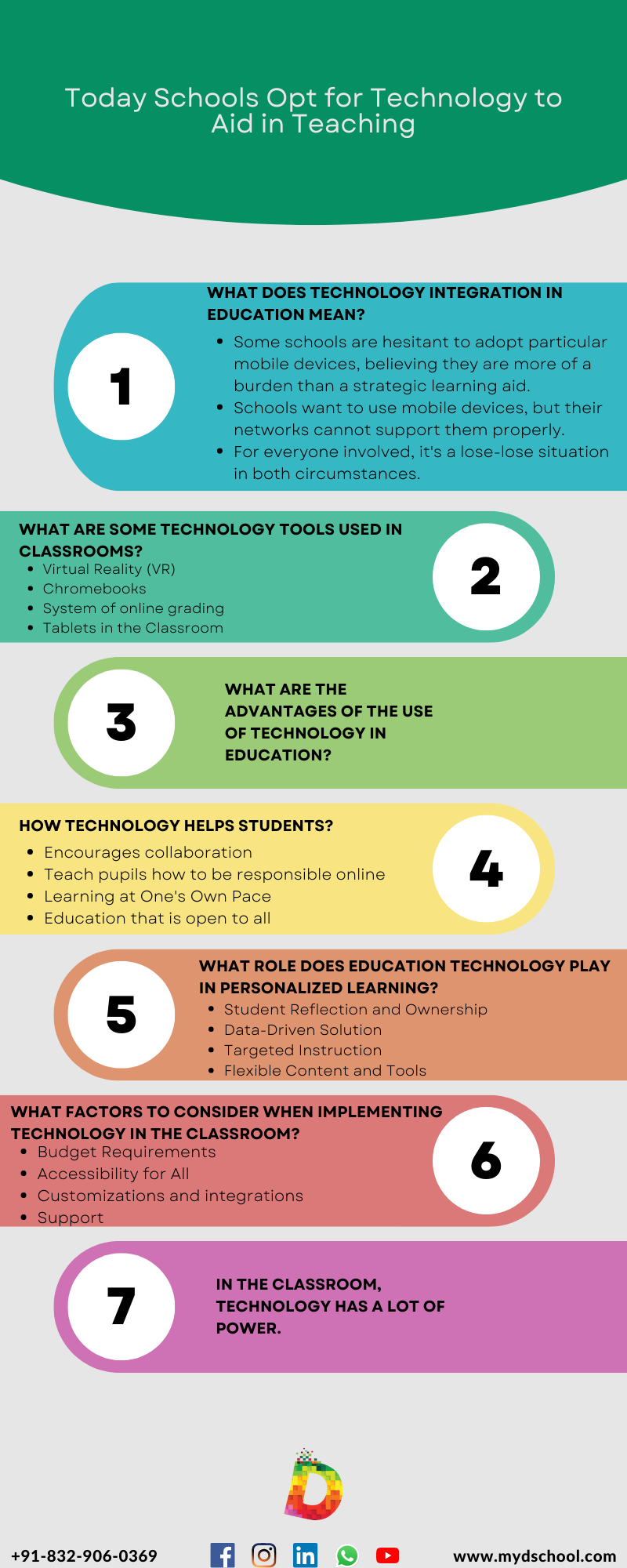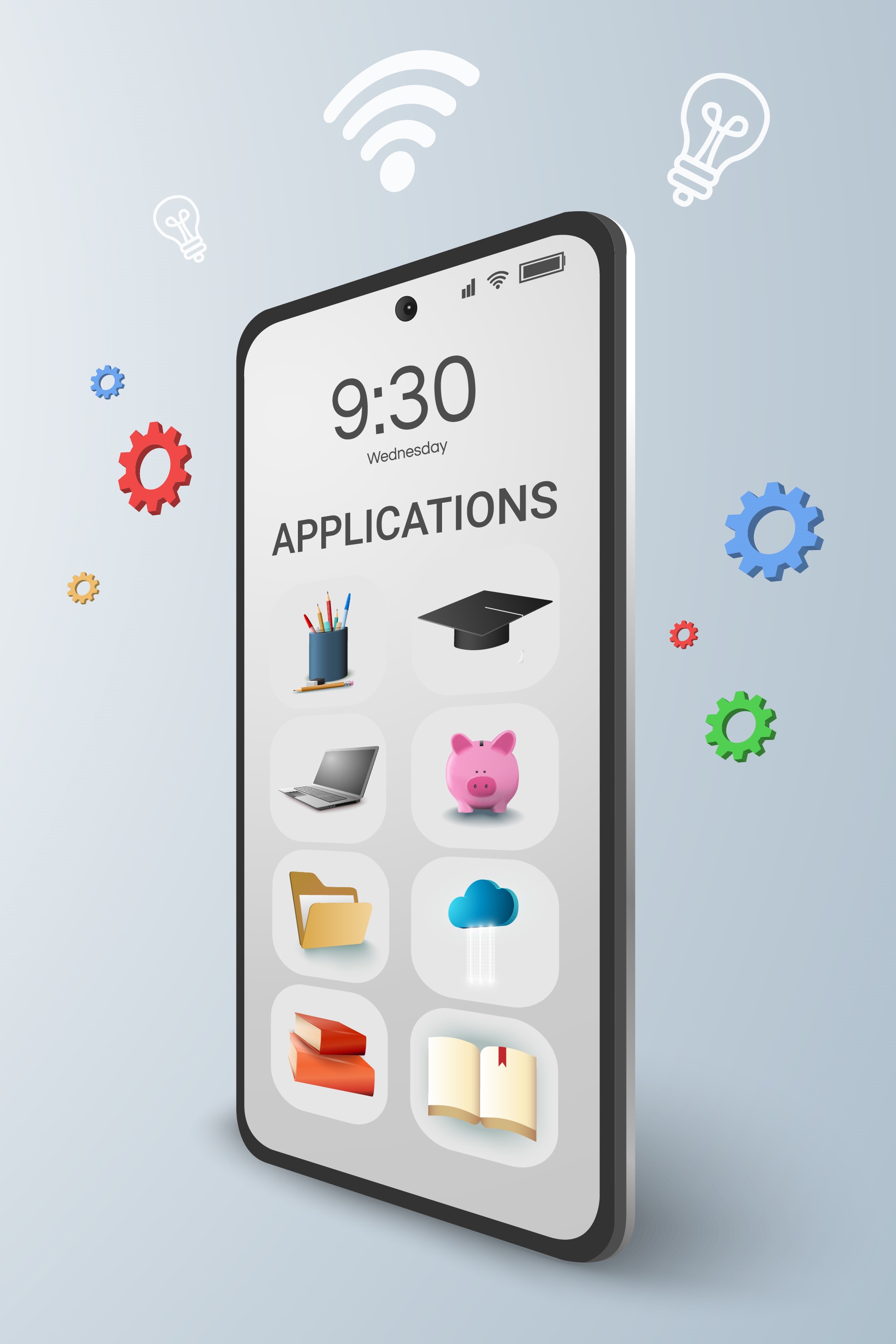Select Category
Categories (17 Blogs)
Today Schools Opt for Technology to Aid in Teaching
Sunday, October 02 2022
Technology

Technology is becoming increasingly crucial in the classroom. Over 80% of the population owns a smart gadget, and we have come to rely on technology. As a result, the classroom must be innovative to engage students and facilitate learning.?

What Does Technology Integration in Education Mean?
?Technology has infiltrated practically every aspect of our culture and has an impact on how we live, work, play, and, most importantly, learn. With mobile and other wireless devices, such as the Internet of Things, becoming more common today, it's only natural that our schools use mobile technology successfully in the classroom. However, for many institutions, incorporating cutting-edge technology is a challenging option.
This is due to two key factors that contribute to the benefits?of technology for students:
-
Some schools are hesitant to adopt particular mobile devices, believing they are more of a burden than a strategic learning aid.
-
Schools want to use mobile devices, but their networks cannot support them properly.
-
For everyone involved, it's a lose-lose situation in both circumstances.
The use of technology to enhance a student's learning experience is referred to as the "integration of technology in education." Learners who are actively engaged with learning objectives are created when different types of technology, including a virtual classroom, are used in the classroom. Technology also paves the door for individualized Instruction to meet the specific requirements of students as individual learners within a larger classroom environment and beyond the?disadvantages of technology in education.
What are some technology tools used in classrooms?
We'll look at some of the most cutting-edge technology and tools transforming the classroom.
- Virtual Reality (VR)?
Virtual reality has a wide range of applications in education. Virtual reality is a computer-generated environment that can be observed via a headset and allows you to explore in a way that is as near to real life as possible. This technology is being used to enable pupils to travel around the world without leaving the classroom. Virtual reality tours of museums are also offered, which are valuable to students.
- Chromebooks
Chromebooks resemble laptops but are significantly less expensive and do not run a wide range of programs or apps. They are designed to run on Google's operating system, and they're made by various companies, including Intel, HP, and Asus, but they're all meant to use the Google Chrome web browser to access the internet. Chromebooks are an excellent option if your school uses Google Apps heavily or relies solely on online information and applications.
- System of online grading
Communication is important in education since it allows instructors, administrators, parents, and students to understand a student's strengths and weaknesses. Teachers can publish grades, examine student attendance patterns, and manage transcript data using online grading systems like MyDSchool, which open and facilitate lines of communication.
- Tablets in the Classroom
Teachers fortunate enough to have tablets in their classrooms can use technology to differentiate lessons throughout the day. Students can work at their own pace, and teachers can provide one-on-one guidance during assignments.
What are the advantages of the use of technology in education??
Teachers want to see their students perform better, and technology can help them. To address the issues, administrators should assist instructors in gaining the skills they need to use technology to improve student learning. Furthermore, using technology in the classroom should simplify instructors' tasks without adding to their workload.
Students benefit from technology because it gives them fast access to knowledge, rapid learning, and engaging ways to practice what they've learned. It allows students, particularly in STEM, to study new disciplines and better comprehend complex concepts. Students can learn 21st-century technical skills needed for future careers by using technology inside and outside the classroom.
Even so, children learn more successfully when they are directed. According to the World Economic Forum, while technology can help young pupils learn and acquire knowledge through play, data suggests that learning is more effective when an adult, such as a teacher, guides them.
Leaders and administrators should assess where their faculty is in terms of their knowledge of online environments. They may now apply solutions for the future based on the lessons learned throughout this turbulent period. Administrators may, for example, give teachers a week or two to consider how to teach courses that have never been taught online before. In addition to looking for solutions,?the impact of technology on education is?critical to be flexible during these challenging times.
How technology helps students?
We've compiled a list of a few?importance of technology in education. Implementing?a student strategy that judicious use of technology in the classroom can boost student engagement and success rates.
-
Encourages collaboration: Many educational technologies provide a variety of collaboration-friendly features. For example, video conferencing systems like Zoom and Skype make it simple for students to hold virtual meetings with classmates worldwide. Students can readily share and edit projects with one another using free online storage systems like Google Drive, fostering better overall collaboration in both the academic and professional worlds.
-
Teach pupils how to be responsible online: Most students are already digital citizens, thanks to the abundance of social networking platforms. Students can begin to learn how to be responsible in the digital world and with their digital actions by introducing technology into the classroom. Students can experience communicating, searching, and engaging with other digital citizens in the classroom, which serves as a microcosm of the larger digital realm.
-
Learning at One's Own Pace: It goes without saying that with the advent of technology in the education business, students now have the opportunity to learn at their own pace. There is no need to skip through a concept when they choose to understand it and encounter any difficulties. While some people are quick learners who can adjust rapidly, others need a long time to grasp a concept. Such children are fortunate to have technology as part of their education; they can now easily keep up with their peers thanks to a thorough knowledge of produced courses and online curricula tailored just for them.
-
Education that is open to all: There are countless free possibilities available from various reputable universities on today's technologically revolutionized planet. You may use your device to access the internet and search for your options no matter where you are. Your grades don't have to suffer any longer because the internet will give you the best of your search results and assist you with your educational demands.
What Role does Education Technology Play in Personalized Learning?
By matching students' specific needs, personalized learning is increasingly regarded as a potential technique for closing achievement disparities, improving student engagement, and preparing students to become self-directed, lifelong learners. The Core Four Elements of Personalized Learning have been established at MyDSchool. These factors can help educators create a winning approach for their district, schools, and classrooms (taken as is or changed by particular districts). They are as follows:
-
Student Reflection and Ownership - encourages students to focus on metacognitive learning processes and pursue their passions while also taking ownership of their work.
-
Data-Driven Solution - Thanks to data-driven decisions, teachers and students can understand and act on their strengths and needs.
-
Targeted Instruction - provides a framework for teachers and students to collaborate on problem-solving and achieve personalized learning objectives.
-
Flexible Content and Tools - offers a mix of resources that respond to students' needs and interests, allowing for various paths, paces, and performance assignments.
Personalization of students' learning experiences is exceedingly challenging to achieve and scale in practice. While technology is not required to personalize learning in general, it is undoubtedly beneficial in how?technology helps students in this pandemic.
What factors to consider when implementing technology in the classroom??
-
Budget Requirements
Consider your funding options and when they'll be available. A one-time investment in technology necessitates the selection of long-lasting technology. However, technology can be replaced more frequently if money is available regularly—budget for professional development, technology support, infrastructure, and classroom renovations and installs.
-
Accessibility for All
"Robust and reliable access to current and developing technology and digital resources" is required for all students, staff, and leaders. Universal access can be achieved by establishing a network that connects all learning spaces or by equipping all learning spaces with document cameras and projectors.
-
Customizations and integrations
Your systems must be able to communicate with one another to automate your internal procedures effectively. As a result, integrating your student information system (SIS) with the many tools you use is necessary. It will assist you in providing a consistent experience for your employees, parents, and kids while increasing productivity.
-
Support
Is there anybody behind the tool who can assist you get started and support you if you have any problems? A robust onboarding program and long-term assistance from the service provider can help you get the most out of the technology you've invested in and stands out as?examples of technologies that improve student learning.
In the classroom, technology has a lot of power.
We live in a world where technology is closely linked. We are becoming increasingly digital in searching for knowledge, sharing our life, and connecting with others. Similarly, more classrooms are turning to technology to provide individualized experiences that engage students and improve learning. Teachers can differentiate instruction using?technology in the classroom to enhance teaching and learning, which accommodates diverse learning styles and aids kids with specific needs and learning issues.
Technology can change not only what we learn but also how we learn. Teachers can provide pupils with immersive, global experiences. It's critical to understand how technology is used in the classroom today, whether you're a parent, a teacher, or an administration.
0 Comments
RECENT POSTS
3 key functions should be in fees management software
Tuesday, November 15 2022
Increasing Parent Involvement via Mobile App
Wednesday, October 19 2022
Is your School Software Provide You Better Service
Wednesday, October 12 2022









Post a Comment